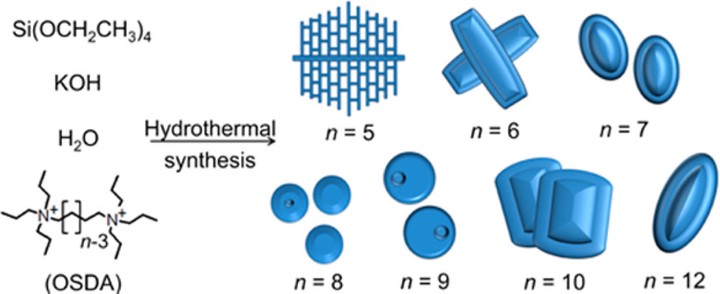Factors Governing the Formation of Hierarchically and Sequentially Intergrown MFI Zeolites by Using Simple Diquaternary Ammonium Structure-Directing Agents

概要
Zeolites with hierarchical structures are of particular interest because such structures can improve molecular diffusion, particularly that of bulky molecules. $N$,$N$,$N$,$N$′,$N$′,$N$′-Hexapropylpentanediammonium cations (Pr$_6$-diquat-5), a simple diquaternary ammonium organic structure-directing agent (OSDA), can direct the formation of hierarchically and sequentially intergrown MFI zeolites without employing any mesoporogens. In this paper, the effects of OSDAs having structures similar to Pr$_6$-diquat-5 but different lengths of alkyl spacers and/or different substituting groups on the phase selectivity and morphology of the resulting zeolites are presented. It was revealed that the number of carbon atoms between two charged nitrogens in the OSDAs significantly affected the intergrowth and morphology of the crystals formed. In addition, the propyl-substituted OSDAs were found to be very selective to the formation of MFI zeolite, whereas the butyl-substituted OSDAs were not. For Pr$_6$-diquat-5, the condition for the formation of hierarchically and sequentially intergrown MFI zeolites was somewhat narrow with the optimized molar composition of 1 SiO$_2$:0.2 Pr$_6$-diquat-5:0.375–0.500 KOH:200 H$_2$O:4 EtOH. Defect lines observed on the obtained zeolite crystals by a transmission electron microscope were considered to be connectors for such intergrowths. The unique intergrowth formed by Pr$_6$-diquat-5 was surmised to be due to the unusual fitting of Pr$_6$-diquat-5 inside the channels of MFI zeolite, which was explained by comparing molecular dimensions and stabilization energies of each OSDA.